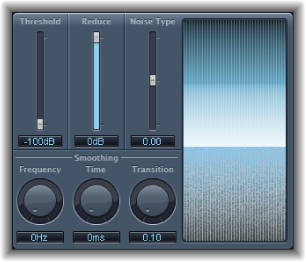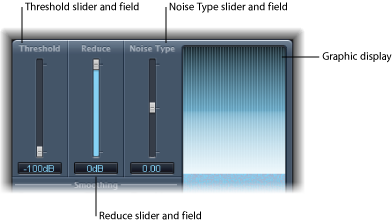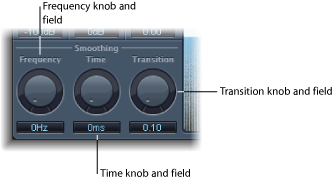Denoiser
The Denoiser eliminates or reduces any noise below a threshold volume level. The Denoiser uses fast Fourier transform (FFT) analysis to recognize frequency bands of lower volume and less complex harmonic structure. It then reduces these low-level, less complex bands to the appropriate dB level. See Denoiser Main Parameters.
If you use the Denoiser too aggressively, however, the algorithm produces artifacts, which are usually less desirable than the existing noise. If using the Denoiser produces these artifacts, you can use the three Smoothing knobs to reduce or eliminate them. See Denoiser Smoothing Parameters.
Locate a section of the audio where only noise is audible, and set the Threshold value so that only signals at, or below, this level are filtered out.
Play the audio signal and set the Reduce value to the point where noise reduction is optimal but little of the appropriate signal is reduced.
If you encounter artifacts, use the smoothing parameters.

Denoiser Main Parameters
The Denoiser offers the following main parameters:

- Reduce slider and field: Sets the amount of noise reduction applied to signals that fall below the threshold. When reducing noise, remember that each 6 dB reduction is equivalent to halving the volume level (and each 6 dB increase equals a doubling of the volume level).
Note: If the noise floor of your recording is very high (more than −68 dB), reducing it to a level of −83 to −78 dB should be sufficient, provided this doesn’t introduce any audible side effects. This effectively reduces the noise by more than 10 dB, to less than half of the original (noise) volume.
- Noise Type slider and field: Determines the type of noise that you want to reduce.
A value of 0 equals white noise (equal frequency distribution).
Positive values change the noise type to pink noise (harmonic noise; greater bass response).
Negative values change the noise type to blue noise (hissy tape noise).
